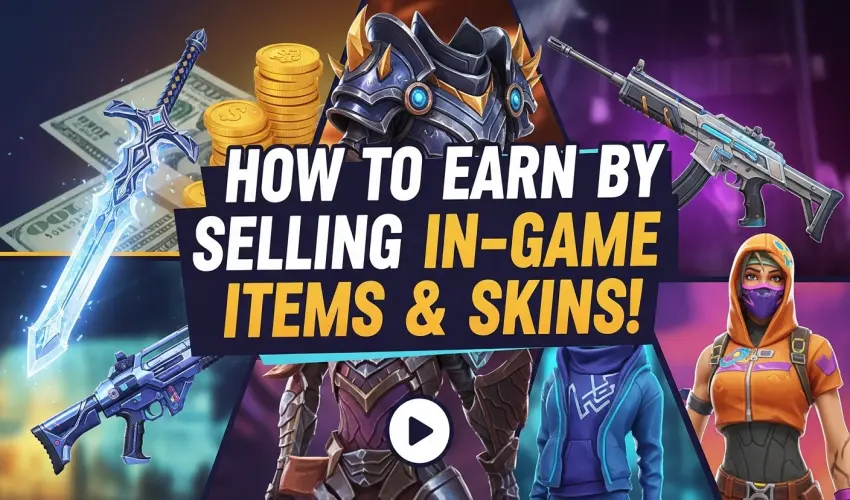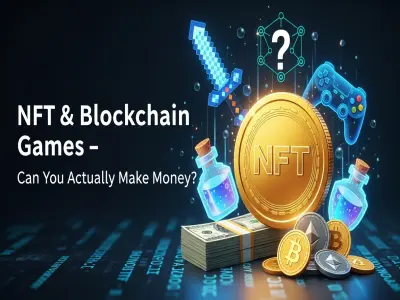How to Earn Real Money by Selling In-Game Items & Skins!
Published Jul 20, 2025
1 0
Key Takeaways
-
A Profitable Hustle: Selling in-game items and skins is a real and profitable side hustle, with players earning anywhere from a few dollars to thousands, depending on rarity and demand.
-
Thriving Economies: Games like CS:GO, Dota 2, Rust, and Fortnite have robust item economies where players actively buy, sell, and trade cosmetic assets for real-world value.
-
Safe Marketplaces: Using reputable marketplaces like the Steam Community Market, Skinbaron, and PlayerAuctions is essential to ensure secure transactions and avoid common scams.
-
Market Knowledge is Power: Understanding supply, demand, rarity, and market trends will significantly impact how much money you can earn.
-
Patience and Strategy: Earning consistently requires patience, smart investing, and knowing the right time and place to sell your virtual goods.
Introduction: Real Cash from Virtual Goods
Once upon a time, video game items were just for fun—bragging rights among friends or a cool-looking set of armor. But not anymore. Today, in-game items and cosmetic skins have real-world value, and players all over the globe are earning actual money by buying, trading, and selling them.
From rare weapon skins in CS:GO to exclusive emotes in Fortnite, virtual goods have become valuable commodities. Some skins are worth pennies, while others sell for thousands of dollars. If you’ve ever wondered how to turn your digital inventory into real profit, you're in the right place.
This guide will walk you through how to earn money by selling in-game items, the best games to focus on, and smart tips to maximize your returns.
What Are In-Game Items and Skins?
Let’s start with the basics. In-game items are digital assets used within a game, like weapons, outfits, or power-ups. Skins, on the other hand, are purely cosmetic—they don’t affect gameplay but change the appearance of your character, weapons, or gear.
These items become valuable when they are:
-
Limited edition or from a one-time event.
-
Rare due to low in-game drop rates.
-
In high demand due to aesthetics or popularity.
-
Tradable or sellable on an official or third-party marketplace.
Why Do People Spend Real Money on Virtual Items?
It might sound strange to spend $1,000 on a digital weapon skin, but the reasons are surprisingly similar to collecting physical goods.
-
Status Symbol: A rare skin shows off a player's dedication, wealth, or seniority.
-
Collector's Mindset: Some players enjoy the hobby of collecting every item in a set.
-
Market Speculation: Many traders buy items hoping to sell them later for a profit, much like stocks.
-
Personalization: Skins let players express their unique style and personality.
-
Content Creator Appeal: Flashy cosmetics can draw more viewer attention on streams and in videos.
As long as players value exclusivity and aesthetics, the opportunity to profit will exist.
Top Games for Selling Items & Skins
Not every game supports item trading, but a few standout titles have built massive, player-driven economies.
1. CS:GO (Counter-Strike: Global Offensive)
This is the king of item trading. Skins for knives and guns can range in value from a few cents to tens of thousands of dollars. Trading happens on the Steam Community Market and trusted third-party sites like Skinbaron and Bitskins.
2. Dota 2
Features a huge market for cosmetic sets, couriers, loading screens, and announcer packs. Items are tradable and sellable via the Steam Market, and their value can fluctuate based on hero popularity or game updates.
3. Rust
This hardcore survival game has a surprisingly heavy cosmetic market. Players can buy and sell custom building skins, weapon wraps, and clothing on the Steam Market and sites like Skinport.
4. Fortnite
While you can’t trade or sell items directly, Fortnite accounts with rare, original skins (like the OG Skull Trooper or Renegade Raider) can sell for hundreds or even thousands of dollars on account marketplaces.
5. Team Fortress 2
The original pioneer of cosmetic trading, TF2 has a long-established economy for its hats, weapons, and crates.
Disclaimer: Always check a game's terms of service. Some prohibit real-money transactions or account selling, so proceed with caution.
Where to Sell Your In-Game Items Safely
1. The Steam Community Market
-
Best for: Steam-supported games like CS:GO, Dota 2, and Rust.
-
Pros: Reliable, easy to use, and directly linked to your Steam account.
-
Cons: Funds are added to your Steam Wallet and cannot be cashed out into real currency.
2. Third-Party Skin Marketplaces (Skinbaron, Skinport, Bitskins)
-
Best for: Cashing out CS:GO and Rust skins for real money.
-
Pros: Trusted by the community, support PayPal and bank transfers, and offer real cash payouts.
-
Cons: Prices may be slightly lower than the Steam Market.
3. General Gaming Marketplaces (PlayerAuctions, G2G)
-
Best for: Selling whole game accounts, in-game currency, or power-leveling services.
-
Pros: Great for games without direct item trading, like selling a rare Fortnite account.
4. Peer-to-Peer Trading (Discord & Reddit)
-
Best for: Advanced traders looking for specific deals.
-
Pros: More control over prices and direct negotiation.
-
Cons: Higher risk of scams. Always use a trusted middleman or escrow service for these trades.
How Much Can You Really Earn?
Your earning potential depends on the rarity and demand of your items, market timing, and a bit of luck.
-
A "StatTrak™ AK-47 | Fire Serpent" in CS:GO has sold for 20003,000.
A Tempered AK skin in Rust can fetch 300500+.
-
A Fortnite account with OG skins can sell for $1,000+.
While massive sales are possible, most players make smaller, consistent sales of items worth $5, $20, or 500 to $2,000+ per month
Strategies to Maximize Your Profits
If you're serious about making money, treat this like an investment.
-
Understand Market Trends: Track item prices over time using tools like Steam Analyst or CSGOFloat. Prices can spike during esports events or after a game update. Buy low, sell high.
-
Invest in Limited-Time Items: Event-exclusive items or skins from discontinued cases often rise in value over time. Buying them early and holding them can lead to big gains.
-
Flip Skins: Buy undervalued items from players looking for a quick sale, then relist them at a higher, market-appropriate price.
-
Specialize in a Niche: Become an expert in one game or one category (e.g., CS:GO knives, rare Dota 2 couriers). You'll spot deals that others miss.
Risks and How to Stay Safe
-
Game Bans: Some publishers may ban accounts for real-money trading. Always read the terms of service.
-
Scams: Avoid shady websites and never trade with strangers outside of a verified marketplace without using an escrow service.
-
Market Volatility: Item values can crash after a game update or patch. Don't invest more than you're willing to lose.
Conclusion: Level Up Your Wallet with Virtual Items
Selling in-game items is one of the most exciting and surprisingly profitable side hustles in the gaming world. It proves that your passion for gaming doesn’t have to be just for fun—it can also fund your next PC upgrade, pay a few bills, or even turn into a full-time business.
Like any market, success depends on strategy, knowledge, and risk management. But if you play it smart, stay informed, and invest your time wisely, you’ll find that pixels can pay—and sometimes, they pay big.







